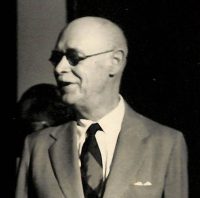Shoreham Hotel.
Quezon busy writing a letter in his own hand to Osmeña in answer to a brief submitted to him by the latter. This is the opening gun in the contest between the two for the presidency of the Commonwealth after November 15, 1943. Quezon read me the salient points of Osmeña’s brief, all of which were citations as to the constitutionality of a government-in-exile. Quezon now points out that all of Osmeña’s authorities refer to formerly independent states now (or formerly) in enemy occupation; these examples are irrelevant, since the Philippine Commonwealth has never been an independent government and the issue now lies between the United States and Japan–so the whole subject is in the hands of President Roosevelt, and he alone can decide what part of the Commonwealth Government and of its constitution are in force today. This leaves little doubt that Quezon will remain as President of the Philippines even after his present term of two years, expiring December 31, 1943, has run out. This would bar Osmeña from enjoying the two years as President to which he was elected by the Philippine people, just before the invasion by the Japanese. Since Quezon is being privately advised by Justices Murphy and Frankfurter, there can be little doubt of the outcome. Opinion around headquarters is that Osmeña will not offer serious resistance.
The part of Osmeña’s offer to Quezon which aroused the latter’s indignation was the proposition that Quezon should continue to live in the magnificent suite in the Shoreham when Osmeña assumed the presidency, and that Quezon should become President of the Council of State, which as he points out was the same old suggestion made to me as Governor General in 1919, [sic] when Osmeña tried to persuade me to disassociate myself from the new Council of State under his own presidency–a proposal which I then rejected.
At all events, Quezon feels that Osmeña’s offer to him now is “insulting.” I have no idea of the contents of Quezon’s letter of reply and probably never shall know but I consider it now practically certain that Quezon will remain as President until at least the Philippines are reoccupied. I had previously told him I did not believe that Roosevelt would tolerate any other plan.
Whether this is politically wise for Quezon is another matter. As Trepp says he weakened his political future when he left Corregidor, and the present project that he shall hold the presidency of the Commonwealth for the two years for which Osmeña had been elected president by the Filipinos, while practically unavoidable, will weaken him still further with the people at home. Quien sabe?
Meanwhile the Japanese radio announcements of statements by leading Filipinos continue to unsettle Philippine headquarters in Washington–however, these are now considered either as downright Japanese lies, or else as statements made under duress. Collier ‘s, May 22, 1943, publishes a recent statement by George Vargas: “It becomes our pleasant duty to share the joy of liberated millions… victory for Japan is victory for the Philippines.” At the same time, the Japanese radio announced that Vargas’ son had been sent to Tokyo to the University–ostensibly for study, but we assume, as a hostage for his father’s “good behaviour.” Manuel Roxas is in his own home in Manila, under “protective custody.” Generals Lim and Capinpin have apparently issued statements that the Americans let them down in the Philippine war and they are in favour of the Greater East Asia Co-Prosperity Sphere. Both of these Generals are now at liberty.
There is evidently still a great deal of ill-feeling among those who surround Quezon (but not in his own mind) because of the failure of the United States to make any effort to relieve Corregidor, after all the abundant promises made to that end in the early stages of the invasion. Mrs. Bewley, who brought her daughter out just before the fall of Corregidor in an American Navy plane to Freemantle, Australia, is still bitter about the lack of effort made by the United States in the theatre of the Philippines. Her husband is a prisoner in Manila–or at Los Baños. Her plane was the only one of the three that got through. One was shot down over Corregidor and all on board lost; one fell in Lake Lanao and all were drowned. This was the end of what had frankly been considered a “suicide mission.”
Quezon took me out for a long drive. I tried to get his mind fixed on pleasant thoughts–got him to tell me of the making of Tagaytay ridge into a resort now by the new road only 40 minutes from Manila–the resort is at 2,500 feet altitude–plenty of water (and wind!).
At Malacañan he has cleaned out the slaughter house and dog pound across the Pasig River and all other “smelly things” on the swampy land opposite the Palace and has turned it all into a park–where I used to shoot snipe! He fears the Japanese will destroy Malacañan if they have to evacuate the Islands. So far they have done no damage there and have not even occupied the Palace.
Secretary Knox told him the Japanese could have taken Dutch Harbor if they had tried; now their occupation of Kiska and Attu really made no difference–we could get them out whenever we cared to try.
Quezon thinks Roosevelt tried to get us into the war immediately after the fall of France but that the American “isolationists” prevented this at that time; it was Pearl Harbor that was the immediate cause of our fighting.
